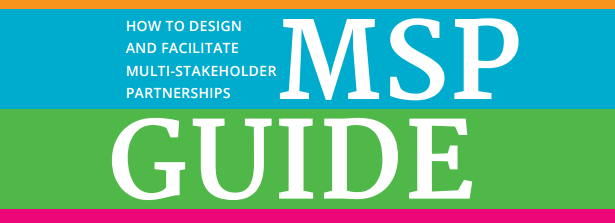How to Design and Facilitate Multi-Stakeholder Partnerships

“Multi-stakeholder partnerships (MSPs) are about changing something with others”, said Herman Brouwer, during the launch of a new book, “The MSP Guide: How to Design and Facilitate Multi-Stakeholder Partnerships” by the Centre of Development Innovation (CDI) of Wageningen University & Research centre on October 6, 2015. “When building a multi-stakeholder partnership, it is important to be clear about what you want to change, with whom, and how”, he added.
This guide helps facilitating these multi-stakeholder processes. It links the underlying rationale for multi-stakeholder partnerships, with a clear four phase process model, a set of seven core principles, key ideas for facilitation and 60 participatory tools for analysis, planning and decision making. The guide has been written for those directly involved in MSPs – as a stakeholder, leader, facilitator or funder – to provide both the conceptual foundations and practical tools that underpin successful partnerships.
Many examples in the guide are from the food and agricultural sector, even if its model and tools are applicable to any sector. Some recommendations in the guide are similar to those identified by the PPPLab, an action research and joint learning initiative about Dutch supported public-private partnerships in the area of food and water, in which CDI participates as well.
Seminar
The book launch was preceded by a seminar about the opportunities and challenges of multi-stakeholder partnerships and the role of facilitators. It reflected on the fast growth of multi-stakeholder partnerships as a preferred modality for tackling complex challenges such as global food security and sustainability. We herewith share a few headlines from that discussion.
Jim Woodhill (Australian Department of Foreign Affairs and Trade), co-author of the report, identified the following key challenges around multi-stakeholder partnerships:
- Partnership financing. Whether a good is considered ‘public’ or ‘private’ has implications for the role of financing.
- Ensuring voice and influence for all, particularly for those at the bottom of the pyramid. For example Grow Asia has producers’, NGOs’ and business councils, which contributes to buy-in from these stakeholders.
- Understanding systemic change further, and use the processes around MSPs to foster it.
- Investing in a good process makes a difference. Engage the leaders, and develop a cadre of skilled brokers and facilitators, as this is a profession that should be honoured and respected. Good brokering requires both the macro and the micro perspective.
Domenico Dentoni (Management Studies Group, WUR, Global Centre for Food Systems Innovation) “We are living in an era of partnership euphoria”. Many companies invest a lot in multiplying their stakeholder partnerships, and research data (2000-2010) show that the number of partnerships correlates with the profit made by these companies. At the same time, pressing problems are not being solved, e.g. water scarcity, land scarcity, inequality. Dentoni observes an “obsession with implementation” among MSP stakeholders, whereas he would recommend this is balanced with some of the elements this MSP guide offers: allowing discussions with outside stakeholders; use the scientific data available and take time for joint reflections and analysis about the problem to be solved. This would offer a stronger basis for effective action.
Minu Hemmati (independent consultant and psychologist). Every individual involved in MSPs brings his/her own personality, history, position in society to the process. It is important to realize this and optimally use one’s background and the related emotions for the benefit of the process in a professional manner. Particular skills are required to deal with complexity. Hemmati recommends to carefully select the communication tools every time, which are fit for the type of objectives you want to achieve, and which create opportunities for mutually supporting each other. She concluded saying facilitating such processes is more challenging than often thought.
A concluding panel session dealt with a series of questions from the audience:
- How are risks of partnerships addressed?
- It would be good, on basis of the assumptions about PPPs, to look at the long-term perspective and the purposes of multi-stakeholder platforms.
- Cultural dimensions need attention.
- Let’s be realistic: MSPs are primarily a space where stakeholders formulate compromises.
- How can we sustain PPPs as a tool to deal with NRM in the long term, after the pilot phase.
- What kind of barriers to effective MSP did researchers encounter within companies?
- How do MSPs end? There should be disengagement moment for a MSP, when actors start acting upon their idea.
At the end of an MSP, it is important to look critically at what they have achieved, said the panel. And to mark the moment: ‘if you bury it, do it with a party’ to celebrate the effort even if it doesn’t continue. Important to note that many MSPs are there, which should not have existed in the first place: there is also case of not starting MSP, rather doing something else. MSPs shouldn’t be seen as a way to solve all kinds of problems in society. (Dentoni, Brouwer, Woodhill)
The background against which many MSPs have been created, is a major crisis in governance. They are an outside form of governance mechanism. Given the huge influence and turnover of global corporations’ work in agriculture, we cannot make any progress in international development if we don’t work with them. NGO’s such as Oxfam have created a context in which the private sector feels they should come to the negotiating table. (Woodhill)
There is a crisis of democracy, while global problems are more ‘wicked’ and more connected. The future of governance is governance processes, not structures. It is important for all stakeholders to build the ability to have a diversity of perspectives around the table, and to become more skilled about these processes. And of course to be aware of cultural differences that will always be there, between stakeholder groups. (Hemmati)
Partnerships have a different orientation: some are more implementation-based, others more dialogue-based. Some intend to promote certain standards along the value chain, starting from the top, and could probably be easily privately funded. Some others generate public goods, and these deserve to be seriously publicly funded. (Dentoni)







1. Integrated community development.
Development facilitation through community organization capacity building for empowerment to sustainable development
2. Facilitation of stakeholder partnership for solving complex challenges to sustainable developement